Much has been written about Chelsea Women this season, from their incredible form to their incoming transfers that have taken the league by surprise. From the arrival of Sam Kerr and the upcoming transfer of former Bayern Munich captain Melanie Leupolz to their incredible form against the top sides of the FAWSL, Chelsea are proving themselves as worthy contenders for the title. During this time, one player has missed a considerable chunk of the second half of the season having played a part between September and December: Fran Kirby. The English playmaker has always been reliable for Chelsea but her injury has kept her out for an extended period, however, once the leagues resume, there is a chance that Kirby could play a significant part of the run-in. Her return will give Emma Hayes a tactical dilemma due to the number of excellent options she has in the forward areas. Throughout this analysis, we will go over Kirby as a player and examine how Chelsea can line up upon her return.
Using tactical analysis, we will discuss the potential systems Hayes can employ to incorporate Chelsea’s best options once Kirby returns from injury. Through this scout report, we will also remind ourselves of the skillset Kirby has and how that can affect the team’s tactics positively.
Playmaking using passing & movement
Kirby’s role has always been one of an attacking playmaker occupying the number 10 position. Both for England and Chelsea, Kirby has been the team’s primary playmaker and link player supplying service for strikers. In recent times, she’s become much more involved in and around the penalty area by being deployed as a centre-forward last season. However, even though she was moved up to a striker role Kirby has retained her style for the most part. She is equally comfortable playing in both roles and can be used in a variety of systems but is most comfortable being the main creator.
Part of Kirby’s repertoire of skills is her passing and movement that makes her a vital player in the final third. It’s important to look at where she’s played in this time, and as we mentioned, her influence has mainly originated from the centre-forward or attacking midfield position. To put this into context, last season she was used as a striker 82% of the games she played (22). From the four games, she’s played this season, she has been used as a striker in 59% of the games. Knowing this, it’s important to understand how she was able to affect games this way. First, we’ll look into how her movement on and the ball plays a part in her game.
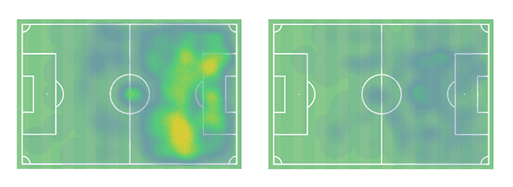
Looking at both heat maps from last season and the few games she’s played this season, it’s clear to see how Kirby has influence across the final third. Part of Kirby’s game is reliant on willing runners going in behind to use the space she creates by dropping deep, driving forward, and threading in through balls. She favours the right side and interchanges with the central midfielders in creating numerical superiority. Kirby’s movement and intelligence to adequately move into these areas helps the team to breakdown low block systems and take advantage of team’s that keep a high line and are possession dominant. This creates openings in behind by either dragging defenders out of position or putting the focus on her so others can run in undetected. Because of the relatively small sample size of data from the current season, I will be referring to data and statistics from the 2018/19 season to put the analysis into context.
According to last year’s statistics, Kirby attempted 2.90 dribbles per 90 minutes with 1.87 dribbles completed successfully. To give this stat a bit more substance she averaged 1.96 for the number of players dribbled past, meaning for every 3 dribbles attempted, she was able to drive past 2 players a game (FBREF). Putting this in context of Chelsea’s tactics, the team looks to play on the counter-attack against more dominant sides such as Arsenal and Manchester City to take advantage of their high line and spaces they leave in behind. Being able to pick up possession in midfield or defence and make progressive runs into the final third without being tackled increases the chances of leading to a goal-scoring opportunity both for herself and her teammates.
As I had eluded to in the previous section, Kirby’s movement is not complete without her adept passing range. The English playmaker is excellent on the ball and is complemented by her range of passing skills. Through balls, crosses, and long-ranged passes are the types of passes that are regularly seen when she plays using them to great effect when playing in her teammates. Kirby’s passing comes into it’s strongest when she picks up possession in midfield and drives forward with players making runs around her. During this phase, she uses her vision and creativity to find pockets of space to pass into. Just like threading a needle. Once she makes the pass, she will make her way into space to receive a potential return pass.
Across 22 games in the FAWSL and Champions League last season, Kirby averaged 4.04 forward passes and 2.27 passes into the box. The numbers could be higher but as we’ve said, her position as a centre-forward skews the statistics by the virtue of her not playing as many passes as should as a number 10. In comparison, she made 5.95 touches in the box showing that once she made the passes from deep, she would make her way into the box to get on the end of passes.
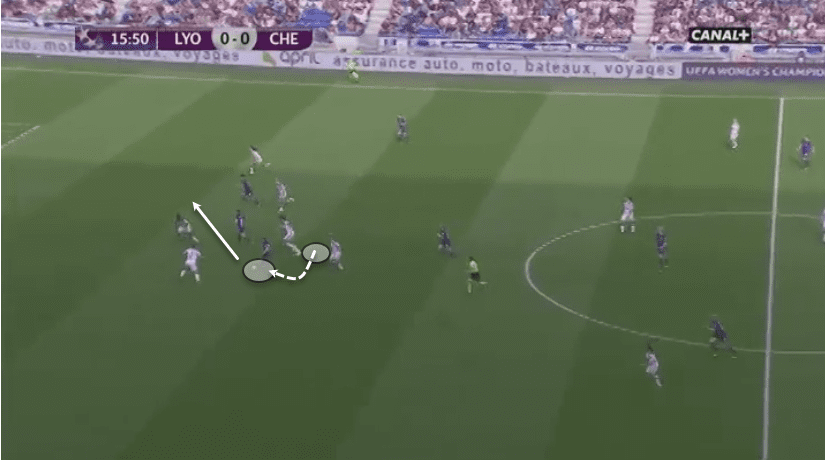
Against Olympique Lyon in the Champions League last year, Kirby displayed her brilliance when playing a the centre-forward illustrating her ability to pick up possession and fashion a goal-scoring chance against the perennial champions. We can see how Kirby picked up possession from a clearance by Sophie Ingle where she controls it and quickly turns the Wendie Renard and drives into Lyon’s final third.
At this point, Kirby is surrounded by multiple players but her control here allows her to release a pass through the crowd of players towards Ji so-Yun. She proceeds to continue her run anticipating a return pass in space. While this move didn’t come off as intended, it shows the intelligence and close control Kirby possesses in possession.
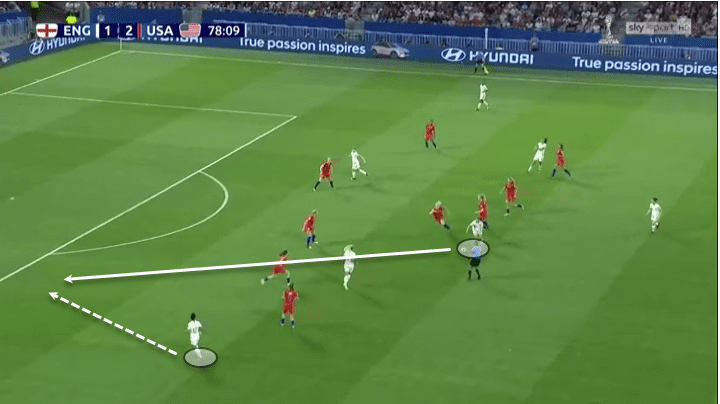
This example against the United States Women’s National Team in the World Cup last year gives us another look at her vision and creativity playing in the number 10 position. Kirby picked up possession in the pocket and drove forward towards the American penalty area. With an incredible first touch and turn, she manages to bypass the first midfielder forcing the Americans to push forward and close the space between themselves and Kirby. This leaves Demi Stokes free on the near side, who makes a diagonal run towards the box. Kirby instantly releases a pass and finds the England left-back.
Off the ball movement
From what we’ve analysed in the previous section, it is clear to see Kirby is an excellent ballplayer with exceptional vision and creative skills to match. Another aspect of Kirby’s play that needs to be discussed is her off the ball movement and positioning. Clearly, she is someone with incredible intelligence on the football pitch and a player that can get into the right place at the right time.
From the examples we used earlier, we could see Kirby attempting to move into the right places to get on the end of moves she started. My only concern is her lack of pace plays a part when Chelsea are looking to counter-attack quickly. In 3v2 or 2v1 situations, Kirby is able to move into good positions but at times lacks the pace to get on to the return or final pass quick enough to complete the move allowing the opposition time to get back.
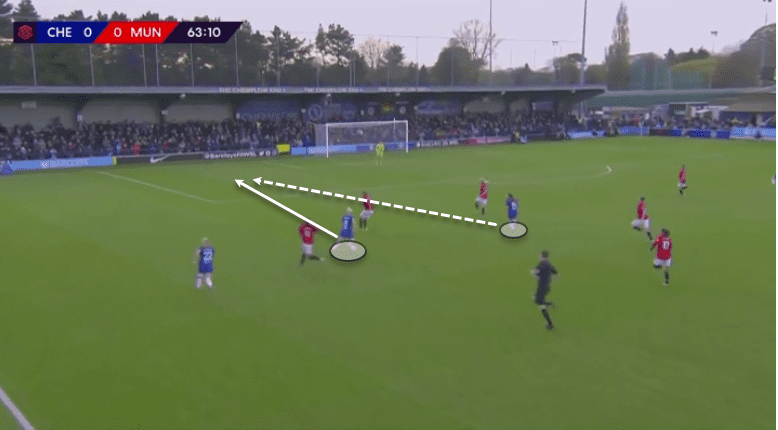
Against Manchester United Women in the league, earlier this season holds an example where pace has let her down slightly. The interchange between Bethany England and Kirby that started deeper in midfield was excellent and allowed them to progress play further forward into United’s half. Once they move into the above situation, Kirby makes the right decision by moving across to get on the end of England’s pass. However, Kirby managed to get on the end of the pass but closer to the touchline by which point the United defender managed to get an interception in to block the cross.
Even though she makes up for the lack of pace through her on the ball skills and other quicker runners around her, Kirby is better suited to playing a role that involves more on the ball movement so she can fully capitalise on her capabilities as an attacking midfielder. This isn’t to say she isn’t a hard-working, willing runner, but rather her skillset is much more inclined towards dictating play than off the ball movements. Now that we understand Kirby as a player, we can now analyse the different systems she can fit into.
What have Chelsea missed?
While we’ve seen glimpses of Kirby this season, she has missed the majority of games. Based on the results and where Chelsea have placed this season, it doesn’t seem as though Chelsea have missed the English playmaker much, however, there is one tactical difference Kirby’s inclusion can help with. When Chelsea play with two natural strikers in England and Kerr, both players, while capable of dropping deep and linking up with midfield, will prefer to work the channels and interchange with each other. Kirby takes up the false 9 role which means her movement isn’t reliant on a specific area, but rather on the situation presented and spaces available to her.
That could be a mixture of dropping into midfield or the inside channels. Whether it be in a 4-4-2 or 4-2-3-1, Chelsea’s shape changes ever so slightly with Kirby in the side. Looking at the average position maps below, we can see the difference in Chelsea’s shape against Arsenal earlier in the season and Manchester City later on. The Blues used a 4-4-2 shape in both matches but the difference with Kirby (#14) in the side is lined up between midfield and attack. The two lines are much more closely correlated and with Kirby’s strength in control in tight areas, her ability to link play would help to break these low blocks. Just as we saw in the earlier example against the USWNT, Kirby can pick up possession neatly and turn players quite easily and release a ball.

Against both Manchester City and Arsenal, Chelsea were up against teams who would look to create a central block when Chelsea attacked. As the image below shows, City have two banks of four and three players with Chelsea’s attacking trio in between.
While the wide spaces are open, City should have enough time to reinforce the central areas to deal with the threats. Kirby could have allowed Reiten to remain slightly wider and use her expert crossing ability to help break City down whilst they focused on trying to close down Kirby.
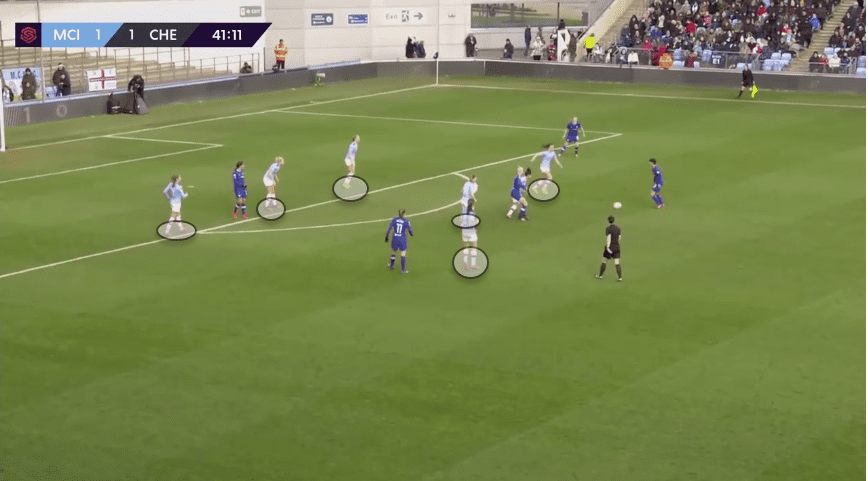
The current system – 4-4-2
It’s important for us to elaborate the current Chelsea system so to better understand Kirby’s attributes highlighted above and how she can fit into the side upon her return. The current season has seen Chelsea adopt a more native 4-4-2 system. This has seen Hayes able to deploy a combination of partnerships upfront including Kirby, England, and Kerr. Ji partners Ingle in a central midfield position. Since Kerr’s arrival, she and England have hugely benefited from this system interchanging and linking up well to penetrate defences. I’ve written an elaborate analysis on Chelsea’s 4-4-2 system (December), Kerr (TFA 2020), and a scout report on England (April) across three different Total Football Analysis Magazine editions if you wish to read an in-depth analysis about the three.
The two banks of four allow for better pitch coverage and defensive solidarity along with more coordinated pressing from the front consisting of a genuine striker and deep-lying/shadow striker/false nine. In this case, Kirby would take up the false nine role, utilising her excellent playmaking skillset to connect play between midfield and attack. The space vacated by Kirby could be taken up by the inverted movement of Reiten.
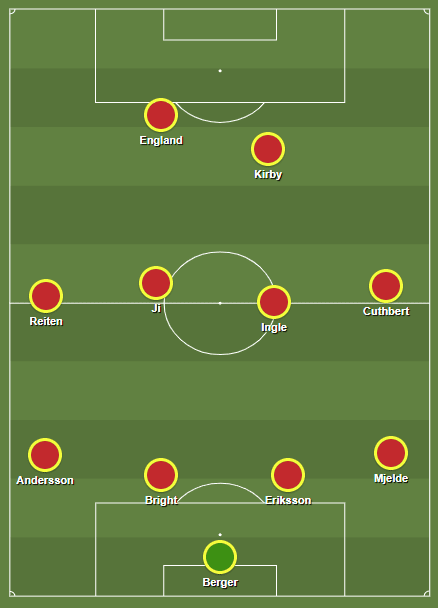
In all likelihood, Hayes will continue with the 4-4-2 system that has given her so much success this season. If that is the case, I can see the above line up as the most plausible one when it comes to playing against teams with low-block systems. Kirby would be able to drop and combine with the likes of Ji and Ingle in midfield and connect the two lines together. With Ji’s box to box abilities, the two could interchange positions creating space for each other whilst dragging the opposition defenders out of position.
4-2-3-1
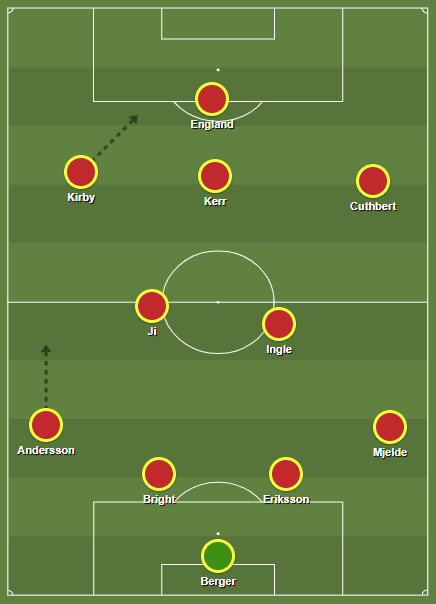
The other formation Chelsea have used in the recent past is the 4-2-3-1 system where Kirby has played as the number nine in the past. However, with both England and Kerr in excellent form and available, it is highly unlikely she would be deployed there again. In this case, there are two options: one being played as the attacking midfielder or as the left-sided winger. Kirby has played as the left winger for the Lionesses and usually plays as a narrow left-sided inside forward putting in crosses from the half-space. She could replicate this for Chelsea, applying her creativity and linking up with the centre-forward effectively creating a two. As a result, this would allow Jonna Andersson to maraud forward from left-back and put in crosses or interchange with Kirby in the half-space. Playing Kirby in this position could be an unlikely option seeing Reiten’s incredible start to life in the FAWSL, however, Kirby presents a different tactical option to Reiten if Chelsea want more focus and penetration in the central areas.
Conclusion
The return of Kirby poses nothing but positives for Hayes and the selection headache posed to her is something every manager hopes for. Her return presents a new tactical option for Hayes against different type of opposition and as we’ve seen in the latter sections of this analysis, Kirby can provide flexibility in her positioning on the field and bring creativity that is currently lacking in the side. Whatever happens, Chelsea will be better for this unwanted break by allowing her to heal up and come back stronger than ever for the title run-in.






Comments